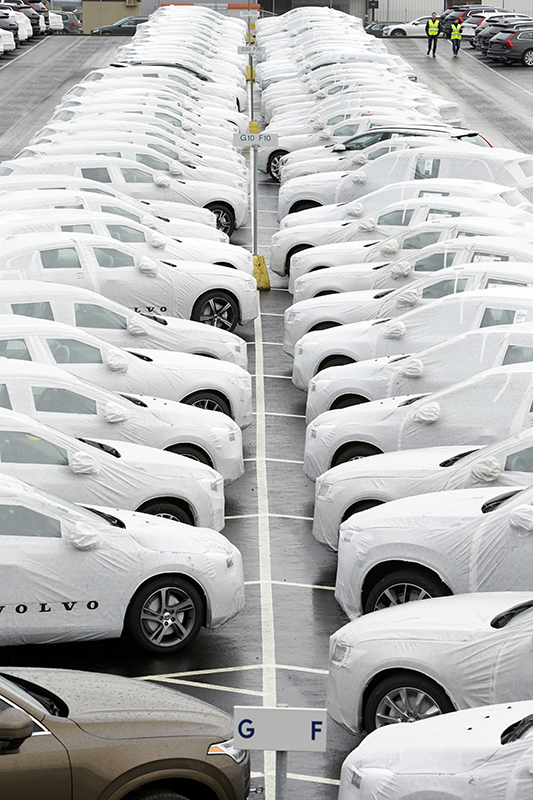 The vehicle yard at Torslanda, at Volvo Cars’ global headquarters in Gothenburg, Sweden, is just one part of the OEM’s growing global logistics operations, but it is a good place to glimpse some important changes and innovations.
The vehicle yard at Torslanda, at Volvo Cars’ global headquarters in Gothenburg, Sweden, is just one part of the OEM’s growing global logistics operations, but it is a good place to glimpse some important changes and innovations.
For example, the global shape of the Geely-owned carmaker’s expanding production footprint can be seen from the vehicles stored at the yard. The plant makes close to 300,000 cars a year, including high-selling SUVs like the XC60 and XC90, most of which move, after a short holding period, directly from the plant to the nearby port of Gothenburg for export. However, the yard also serves as a distribution centre for the Swedish market and holds models imported from Volvo’s plant at Ghent, Belgium, such as the XC40 and the new V60; and S90s sedans imported from China, which arrive at the port of Zeebrugge in Belgium by rail and move to Sweden by ship.
By early 2019, some American-built models will probably be seen here too, after Volvo opens a new plant in Charleston, South Carolina. The factory will become the global centre for the new S60 sedan and will add the second-generation XC90 SUV by 2021, when production capacity reaches 150,000 units per year.
While the Torslanda yard holds mostly new vehicles, it also has a large area for used cars, including those coming off leases or special-purpose vehicles like those for police and medical services in Sweden. These are inspected and readied for remarketing, and truck carriers arriving at the plant combine loads of new and used vehicles based on delivery destinations.
Look carefully, and it is also possible to see changes in the yard that signal Volvo’s shifting approach to logistics management. For example, after Volvo Cars brought logistics management in-house in 2012, moving away from a long-standing arrangement with Volvo Group Logistics Services (previously Volvo Logistics, part of the commercial vehicle division of Volvo Group), it also switched yard management operators, using a number of facilities around the port of Gothenburg, including rail dispatches from Gothenburg to Södertälje, south of Stockholm.
As Volvo’s volume increased and its logistics organisation grew, the carmaker made further changes. In 2015, plant yard operations were brought in-house. Malin Veteli, yard operations manager, points out that the rail loading operation for the daily service was also brought to the plant in 2017.
“In bringing the operation back we could make better use of our capacity at the plant and of our staff, as we are now operating the yard with Volvo employees, using Volvo systems,” she says.
Not every innovation here is visible to the naked eye, however. All of the operations at the Torslanda yard are controlled via IT systems which are now standard across Volvo worldwide. Vehicles moving from the plant to export or distribution, meanwhile, are managed via a transport management system (TMS) which includes route and network optimisation, carrier management and invoicing. This has been implemented across global outbound and inbound logistics, including for China and the US.
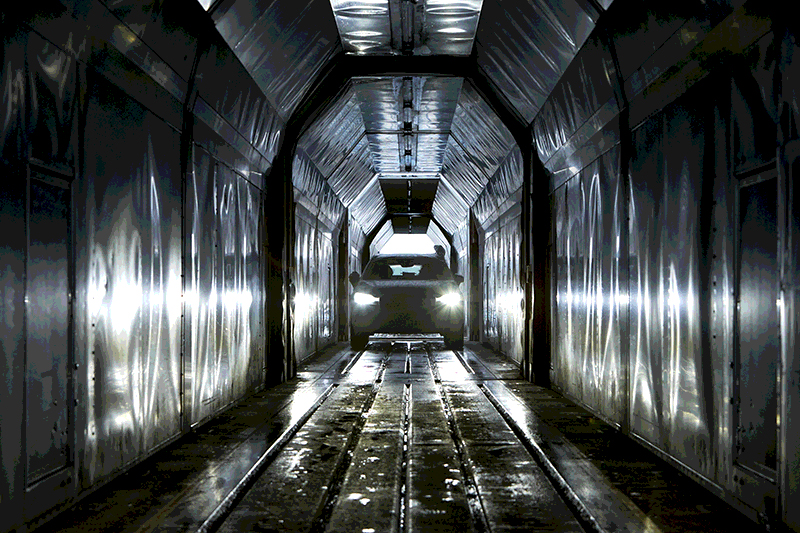
Maintaining control
The insourcing of logistics has been among the defining features of Volvo’s supply chain management since the Geely acquisition.
Michel Torreborre, vice-president of supply chain management and the top executive leading Volvo Cars logistics, says that changes like bringing yard management and other operations at Torslanda back in-house have been business decisions that reflect Volvo’s drive to make better use of its assets amid rising volumes, as well as to maintain strong process control and visibility.
Torreborre’s organisation has now grown to include functions such as pre-series and future programme logistics planning, transport network design, packaging engineering and global customs.
Whereas previously, the central logistics team in Gothenburg controlled operations in Europe but set governance and processes for regional teams, as of 2018 the regions now report to Torreborre, including for vehicle logistics.
“In the last four to five years, we have nearly tripled the organisation to almost 600 white-collar staff, not including staff working in plants, warehousing or yards,” says Torreborre. “We are now represented everywhere on a global scale, which is not something our logistics organisation has done before.”
The organisation does not extend to other Geely brands, even those in which Volvo has ownership stakes like Lynk & Co and Polestar, which have their own logistics organisations. “We are supporting Polestar with processes and standards and will look for synergies where available, but otherwise we are completely separate,” says Torreborre.
 “In the last four to five years, we have nearly tripled the organisation to almost 600 white-collar staff, not including staff working in plants, warehousing or yards. We are now represented everywhere on a global scale, which is not something our logistics organisation has done before.” - Michel Torrebore, Volvo Cars
“In the last four to five years, we have nearly tripled the organisation to almost 600 white-collar staff, not including staff working in plants, warehousing or yards. We are now represented everywhere on a global scale, which is not something our logistics organisation has done before.” - Michel Torrebore, Volvo Cars
Volvo has seen double-digit cost savings and improvements in performance, including equipment utilisation and lead times, he adds.
In outbound, the team’s ability to analyse and engineer logistics flows has been an important way to mitigate a growing shortage of trucks and drivers, helping to ensure the capacity Volvo needs to keep up with its vehicle launches. Production of the XC40 started in November at Ghent, while the OEM recently revealed its new V60 estate car. This capability is also key in China, where changes to maximum truck sizes and payloads are reducing available capacity.
Taking more control of its logistics, including through the global TMS, has also helped Volvo to predict and track lead times for vehicle deliveries. Torreborre wants to increase this visibility to pull in more real-time information, such as via telematics and other GPS technology. But this is not about knowing where vehicles are at any given minute.
“For outbound, I don’t think we need to see where every car is all of the time. Rather, we need to know that it has boarded a vessel or reached a point of rest,” he says. “We have room for improvement in these areas and have specific projects in both inbound and outbound logistics.”
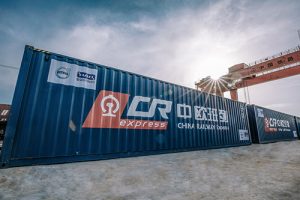 The ‘China Europe Railway Heilongjiang-Zeebrugge Railway’ has been delivering Volvo cars since June last year
The ‘China Europe Railway Heilongjiang-Zeebrugge Railway’ has been delivering Volvo cars since June last yearImported Volvo vehicles started arriving at the port of Zeebrugge, Belgium, in June 2017 from its plant in Daqing via Russia, Belarus, Poland and Germany. The deliveries are part of a new rail service dubbed the ‘China Europe Railway Heilongjiang-Zeebrugge Railway’, which is scheduled to have more than 300 departures from Heilongjiang annually, according to the port of Zeebrugge.
Zeebrugge’s rail partner for the New Silk Road Heilongjiang-Zeebrugge connection is China’s Changjiu Logistics Group, with which the port signed a memorandum of understanding for the launch of the China Europe Railway last June.
China-Europe rail reality
Volvo’s logistics teams have been pushing through important changes and difficult projects at a fast pace. Its project to export S90 sedans from China to Europe is in itself a significant development. But Volvo’s decision to move all vehicles via a block train service between China and Zeebrugge made the move historic.
“We implemented the train service at a record tempo, in around six months for everything,” says Torreborre. “We did a lot of testing, including of route quality, of the racks, and of loading and unloading, and so far the quality is very good.”
The block train service, which is made up of 41 containers, each carrying three cars, is currently running around four times a week. Torreborre expects this to settle at around three trains a week this year. Vehicles move from Daqing, in north-east China, to Zeebrugge, from where they are taken on to European destinations by road or ship.
While the winter months may expose problems, the main issue so far has been a 10-20% variation in expected delivery time as a result of track works, he says. At around three weeks, however, the delivery time is still nearly two-thirds faster than using ro-ro services.
Volvo is also exploring potential return loads for exports from Europe to China. This past autumn, for example, it exported a trial shipment of V40s built in Ghent to China. The carmaker has also experimented with shipping parts and materials, and wants to explore the potential of adding other stops along the route, such as Chengdu, in south-west China, where Volvo has another plant and where more vehicles can be dropped off or picked up.
“But we are still in the concept phase and have not yet decided what we will do further,” says Torreborre.
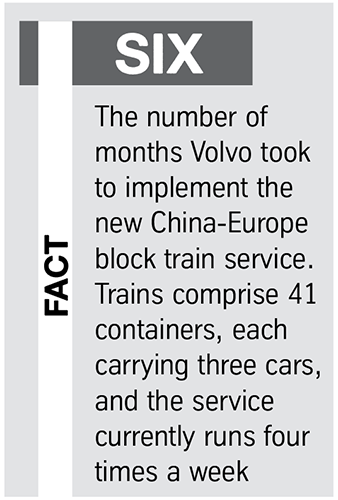 One thing Volvo has ruled out so far, however, is opening up the service to other manufacturers. Volvo has secured block trains and Torreborre does not want to sacrifice the control and reliability of a dedicated service by having to depend on other companies. “As soon as you involve other companies, you have issues over timing that could impact visibility, so we have no plans for sharing capacity with others,” he says.
One thing Volvo has ruled out so far, however, is opening up the service to other manufacturers. Volvo has secured block trains and Torreborre does not want to sacrifice the control and reliability of a dedicated service by having to depend on other companies. “As soon as you involve other companies, you have issues over timing that could impact visibility, so we have no plans for sharing capacity with others,” he says.
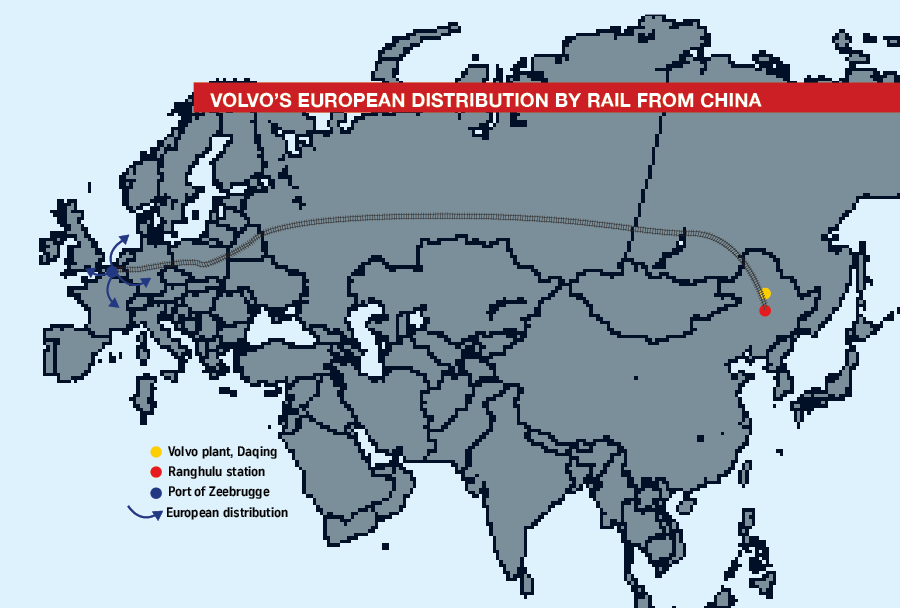 Volvo’s China-EU rail route – click to enlarge
Volvo’s China-EU rail route – click to enlargeFor Torreborre, using block train services for vehicles along the route is not only an industry first from China but also a sign of how Volvo’s integrated logistics management team can plan and implement complex services. Volvo worked not only to develop the container racking solution and coordinate transport, but also on customs and trade regulations. Putting the service in place has emboldened the carmaker to look at further rail solutions, not only as part of the ‘One Belt, One Road’ initiative, but also more widely across Europe – where currently Volvo only uses rail to Södertälje.
“We have been very conservative in using rail for vehicles in Europe and not gone beyond this single flow, but our experience shipping from China is making us look again at new opportunities,” he confirms.
Thinking big in America
Volvo is also preparing to be bold in the US. The carmaker has ambitions for the Charleston plant to help double sales in the country, as well as to export the S60 globally, transforming its regional and global vehicle logistics.
“We have designed the plant to have a direct rail connection that will allow us to take in goods and ship cars,” Torreborre says. It will also have a vehicle processing centre (VPC) onsite to handle cars for US distribution. As a result, Volvo will bring in more imports through the port of Charleston as well, so they can be combined with locally produced cars. It will, however, also continue to use existing ports of entry in the east including Newark (New Jersey), Baltimore (Maryland) and Brunswick (Georgia).
“We won’t bring all the imported cars to Charleston, but we will send a certain number through the plant VPC,” says Torreborre. “The port of Charleston will become more important for us.”
A focus on the basics
As vehicle technology itself develops – in particular in terms of electric and autonomous vehicles – Torreborre is conscious that his supply chain organisation must remain forward-looking, especially in considering how such technology might change logistics in the near and medium term (see box, below).
But despite all the excitement around such technological change, he does not lose sight of the day-to-day problems making the biggest impact, such as truck and driver shortages. And on this score, Torreborre believes that while technology, better management and visibility can mitigate any problems, vehicle hauliers need to get a better handle on their basic business processes.
“I think carriers have to get better at planning and to find ways to improve their business model by offering shippers the empty capacity that they have on return legs, which is basically free capacity,” he says. “It is about carrier management from the service providers to optimise their business.”
Such perennial issues are a reminder that there is always room for improvement and that Volvo’s relatively small size can leave it struggling when capacity is tight. But the carmaker’s recent successes in logistics point to a willingness to change and innovate. And that should serve it, its logistics partners and its customers very well.
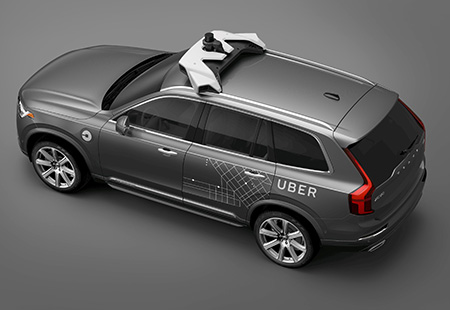 Volvo Cars’ Autonomous Driving Brain (below) will be fitted to thousands of vehicles for Uber from 2019 to 2021, including the scalable product architecture 90 series and the XC60
Volvo Cars’ Autonomous Driving Brain (below) will be fitted to thousands of vehicles for Uber from 2019 to 2021, including the scalable product architecture 90 series and the XC60Volvo’s plans to add more battery-electric vehicles to its range will have some obvious implications for inbound and outbound logistics, including in terms of the additional weight of lithium-ion batteries.
“We will fully support the electrification strategy, and we are currently studying how to handle the challenges of heavier batteries and vehicles,” says Michel Torreborre.
Volvo Cars is also active in developing and partnering companies for autonomous vehicle development, including Swedish tier supplier Autoliv, as well as with tech companies on both supply and engineering. The carmaker will supply thousands of autonomous driving-compatible vehicles to  Uber between 2019 and 2021 on its scalable product architecture, which includes the 90 series and the new XC60, and is also working on autonomous driving development with the ride-sharing firm.
Uber between 2019 and 2021 on its scalable product architecture, which includes the 90 series and the new XC60, and is also working on autonomous driving development with the ride-sharing firm.
The OEM aims to offer fully autonomous vehicles by 2021. A project in Gothenburg between Volvo and several government authorities is already testing 100 autonomous vehicles in designated areas.
In addition, Michel Torreborre points to trials in which Volvo has used automated driving features in yard operations, for example.
Over the past two years, there have also been trials as part of a research project named ‘Born to Drive’ that uses autonomous vehicle technology in logistics processes, which has included Volvo, government agencies and a number of technology firms such as Actia, Combitech, Consat and Semcon.
Another pilot is set to begin in Sweden this year between Semcon and Volvo Bil, a car dealer owned by Volvo which is responsible for distributing cars to Volvo Car and Volvo Group employees in the country.
According to these companies, the project will look to introduce autonomous processes in the vehicle handling and handover processes.
 Further changes to mobility, such as shared driving and subscription pricing, could further change outbound logistics models. Already Volvo, Lynk & Co and Polestar are preparing to increase such offerings to customers, so the changes could start happening much sooner than later.
Further changes to mobility, such as shared driving and subscription pricing, could further change outbound logistics models. Already Volvo, Lynk & Co and Polestar are preparing to increase such offerings to customers, so the changes could start happening much sooner than later.






































